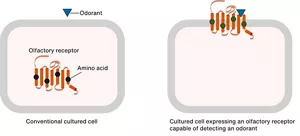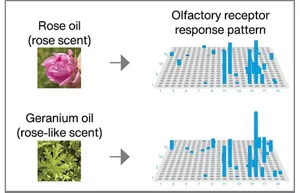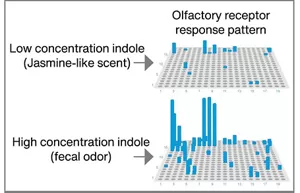Establishment of Technology That Analyzes the Responses of Approximately 400 Olfactory Receptors
Discovery That Each Odor Has a Specific Pattern
Kao Corporation’s Sensory Science Research Laboratory has become the first in the world*1 to successfully express on the surface of cultured cells almost all of the approximately 400 types of human olfactory receptors, and has established ScentVista 400TM, a technology that comprehensively analyzes how olfactory receptors respond to odorants. This technology suggests that the human sense of smell can be understood through the response patterns of olfactory receptors to odorants.
Video. ScentVista 400 Technology Analyzes Responses of the Approximately 400 Olfactory Receptors
The results of this research were presented at the 59th Annual Meeting of the Japanese Association for the Study of Taste and Smell (September 8–10, 2025, Osaka), and received the Excellent Presentation Award.
-
* 1 Based on Kao’s search of academic papers on PubMed, the world’s leading scientific literature database for life sciences and biomedicine field, using the keywords “human,” “odorant” and “receptor.” No publications describing the expression of all of the approximately 400 types of human olfactory receptors on the surface of cultured cells were found as of August 28, 2025.
Background
The human nose contains approximately 400 types of olfactory receptors, each acting like a sensor that can detect specific odorants from among hundreds of thousands that exist. This information is transmitted to the brain, where it allows humans to sense odors.
In order to investigate how humans sense odors, it is necessary to ascertain how olfactory receptors respond when they recognize odorants. Because direct experimentation within the human nose is not feasible, researchers commonly use cultured cells instead to express olfactory receptors. In the nose, these receptors are present on the cell surface, where they can recognize odorants. In cultured cells, however, olfactory receptors often fail to localize to the cell surface and remain inside the cells instead, where they cannot detect odorants. As a result, only about 10% of human olfactory receptors have been studied successfully to date.
To address this challenge, in 2023 Kao developed a technology that allows olfactory receptors to be expressed on the cell surface, and one consequence was the identification of an olfactory receptor that detects musk*2 .
Kao has applied this technology to establish a method for comprehensive analysis of the responses of approximately 400 types of olfactory receptors, including those previously uncharacterized. Using these response patterns, Kao sought to elucidate the mechanisms underlying odor recognition and advance understanding of the human sense of smell.
-
* 2 “Discovery of an Olfactory Receptor That Comprehensively Recognizes Musk—Enabling Accurate Prediction of Musk Fragrance Profiles from Chemical Structures,” Kao News Release, September 13, 2023.
Development of Technology for Comprehensive Analysis of Approximately 400 Human Olfactory Receptors
Olfactory receptors are proteins that comprise chains of amino acids. Kao researchers investigated the human olfactory receptors that had been difficult to analyze. They identified the specific amino acids that prevent these receptors from appearing on the surface of cultured cells and substituted them with amino acids expected to resolve this problem. This allowed nearly all olfactory receptors to be expressed successfully on the surface of cultured cells, enabling the recreation of conditions under which odorants are recognized (Figure 1).

Figure 1. Difference in olfactory receptor localization in cultured cells before and after amino acid substitution
Building on these findings, Kao researchers developed ScentVista 400, a platform in which nearly 400 olfactory receptors are individually expressed in cultured cells housed in separate wells on a microplate, allowing simultaneous measurement of receptor responses when odorants are introduced.
Discovery of Distinct Receptor Response Patterns for Each Perceived Odor
Using ScentVista 400, when an olfactory receptor detects an odorant, it emits light, and the intensity of the light confirms the receptor’s response. This technology was used to investigate how approximately 400 human olfactory receptors respond to various substances perceived as pleasant or unpleasant. The results revealed that similar odors have similar receptor response patterns, while those that are different have different patterns.
For example, rose oil, which is made from petals, and geranium oil, extracted from leaves and stems, both have similar scents despite being derived from different kinds of flowers and different parts of the plant. Kao elucidated that the olfactory receptor response patterns of rose oil and geranium oil are also similar. Kao also investigated indole, a substance that has a pleasant, jasmine-like floral scent at low concentrations but an unpleasant fecal odor at high concentrations and found that its olfactory receptor response pattern varies with concentration (Figures 2 and 3).
These findings demonstrate that the human sense of smell is based on patterns of olfactory receptor activation.

Figure 2. Similar olfactory receptor response patterns from different fragrance raw materials with similar scents

Figure 3. Olfactory receptor response patterns vary with concentration of the same odorant
Summary
Kao is the first in the world to successfully express nearly all of the approximately 400 types of human olfactory receptors on the surface of cultured cells. Building on this achievement, Kao has developed ScentVista 400, a technology that enables comprehensive analysis of how these receptors respond to odorants. Using this technology, Kao has identified that each kind of perceived odor quality corresponds to a specific olfactory receptor response pattern.
These findings suggest the potential to transform the perception of unpleasant odors originating from people, clothing, or living environment into pleasant ones through modification of response patterns using new fragrances with excellent deodorizing effects. This technology may allow the same odorant response patterns to be achieved using fewer and smaller quantities of fragrance raw materials.
Kao remains committed to deepening its understanding of the nature of the sense of smell and to creating fragrance experiences that bring joy to consumers around the world.
-
* This news release is an English translation of the original Japanese-language release issued on September 24, 2025.
About Kao
Kao, a Japan-based manufacturer of personal care and household products, cosmetics, and specialty chemicals creates high-value-added products and services that provide care and enrichment for the life of all people and the planet. Through its brands such as Attack, Bioré, Jergens, Laurier, Curél, SENSAI, MOLTON BROWN, and Oribe, Kao is part of the everyday lives of people across Asia, the Americas, Europe, the Middle East, and Africa. The Chemical Business also contributes to a wide range of industries. Utilizing its capabilities in precise interface control technology, the Chemical Business applies its deep knowledge in the areas of fats and oils and polymers to provide a variety of products and solutions. From daily necessities to electronic materials, agricultural products, asphalt additives and more, Kao works to provide solutions for broad industry needs and social issues. With about 1,630 billion yen in annual sales, Kao employs about 32,600 people worldwide and has more than 130 years of history in innovation.
Please visit the Kao Group website for additional information.
Media inquiries should be directed to:
Public Relations
Kao Corporation
